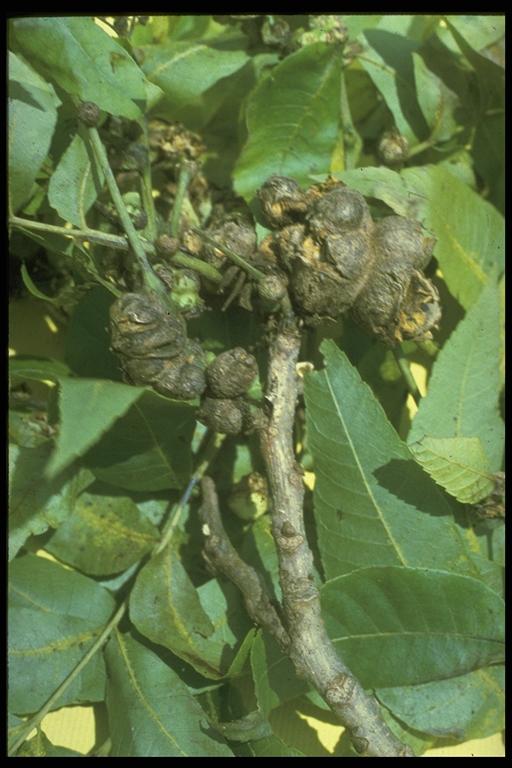
Gall-forming aphids, Pemphigus sp. (Homoptera: Phylloxeridae). Photo by C. L. Cole.
Common Name: Gall-forming aphids
Scientific Name: Pemphigus sp.
Order: Homoptera
Description: Galls are produced by small, soft-bodied insects that are similar and closely related to aphids. They live inside hollow galls formed on new-growth leaves or twigs that may reach about 1 inch in diameter. Leaf galls remain green and fleshy until they have opened. Twig and stem galls are woody and may remain on the tree for several years.
Gall-forming aphids, Pemphigus species, also occur on petioles and twigs of cottonwood. They can be identified by the size and shape of the galls and characteristics of the exit holes produced when the galls split open.
Life Cycle: Phylloxera overwinter in the egg stage in bark crevices. Eggs hatch around bud break in the spring and tiny nymphs begin to feed on tender young growth, releasing a substance that stimulates the plant tissue to develop galls. After developing into adults in 4 to 5 weeks, females deposit clutches of eggs inside the galls or on fresh, young growth. Nymphs hatching from these eggs develop inside galls. Within 3 weeks, the galls split open and release the phylloxera. Phylloxera can have several generations. However, the stem phylloxera has only one damaging generation per year.
Habitat and Food Source(s): These species occur on pecan. Other species of phylloxera that cause galls on leaves and stems of hickory.
Pest Status, Damage: Four species cause galls on leaves, twigs and nuts of pecan trees. Although unsightly, galls caused by the pecan leaf phylloxera (Phylloxera notabilis Pergande), are not particular damaging although they cause infested leaves to drop early. Galls on twigs, caused by P. devastatrix Pergande, can lead to mid-season (July) defoliation and twigs breaking off during windy weather or excessive weight that results in reduced yield and misshapen trees.
Management: See gall-making insects and mites.
For additional information, contact your local Texas A&M AgriLife Extension Service agent or search for other state Extension offices.
Literature: Carter et al. 1980; Johnson & Lyon 1988.